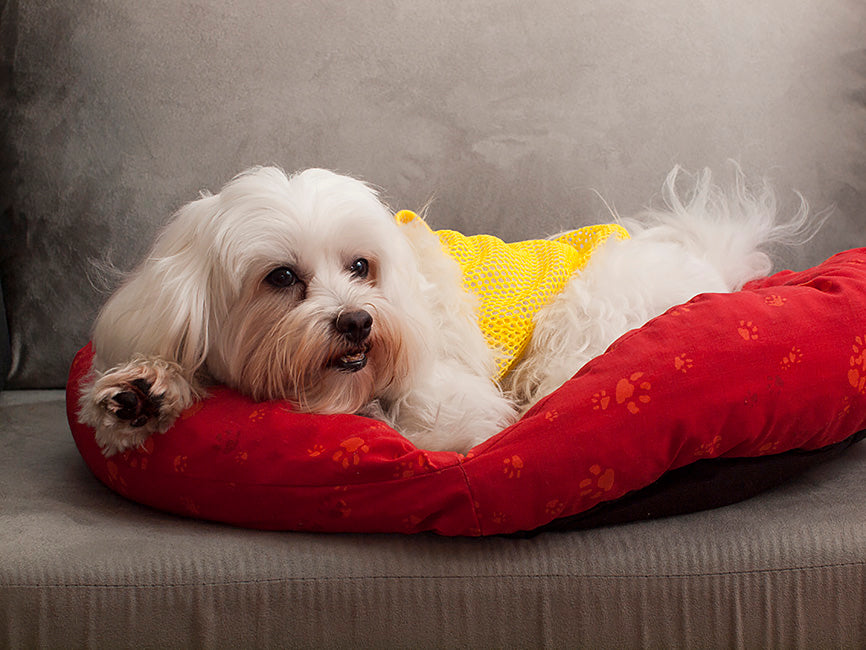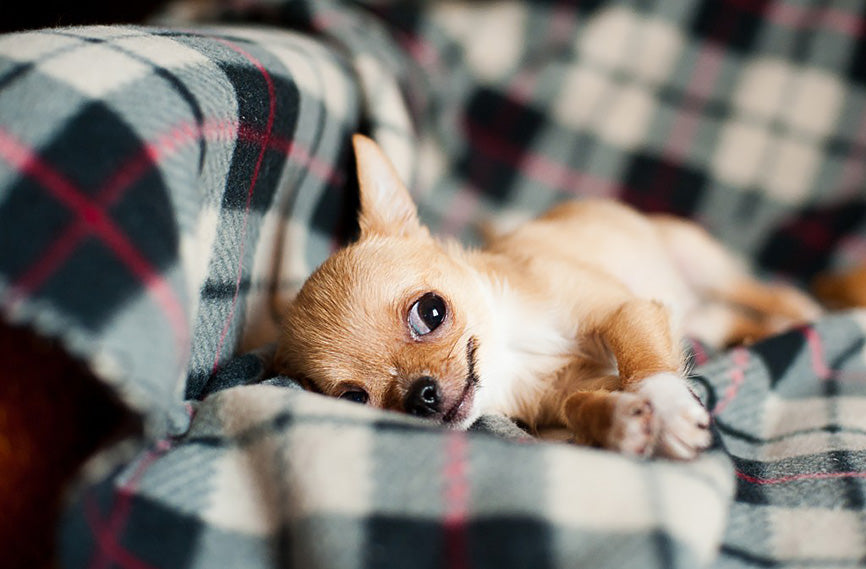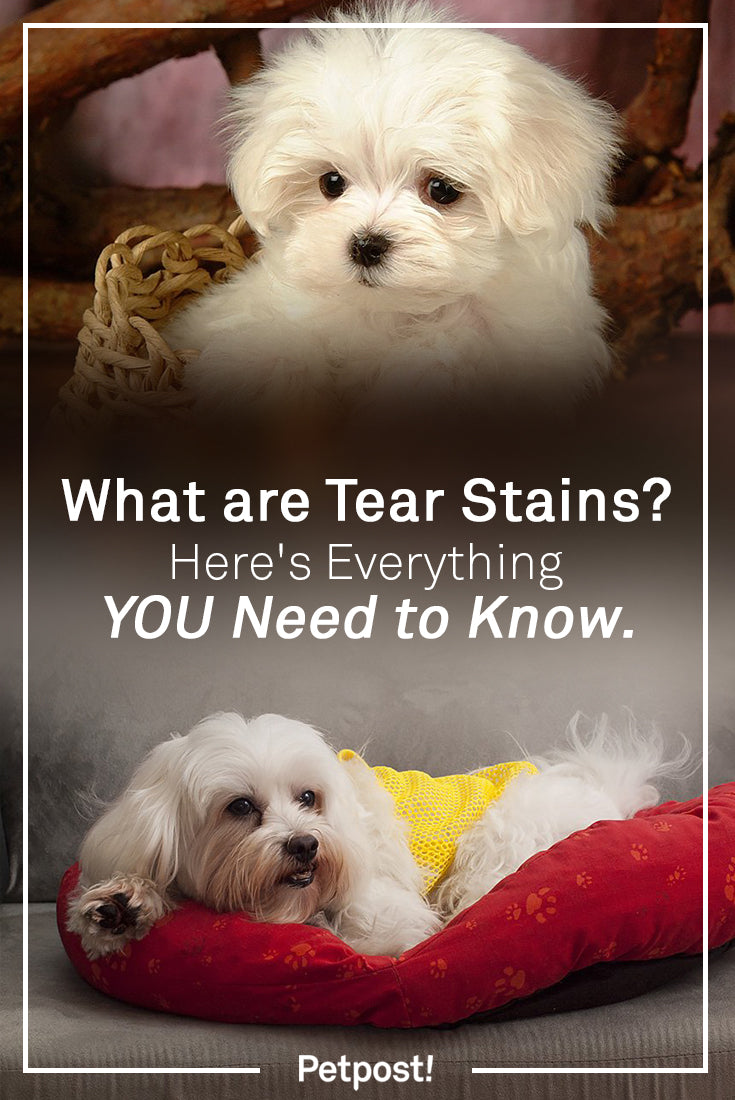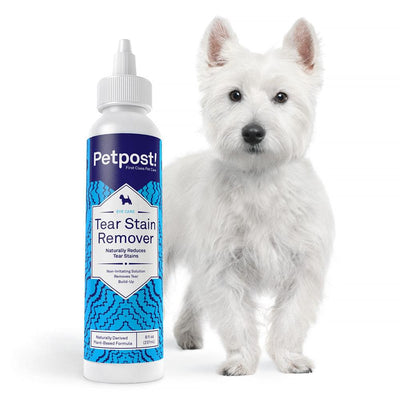What are Tear Stains? Here's Everything YOU Need to Know.

Does your beautiful white puppy look like she took a right hook to the face? Would you love to get rid of those reddish brown streaks running down her nose and lips?
While completely harmless, tear stains can cause a rather unsightly discoloration below the eyes and mouth. In some cases, they can also provide a home to bacteria or yeast that can irritate your pet’s skin and cause discomfort. Cleaning the area regular prevents an infection as well as helps to remove the unsightly blotches.
Causes of Tear Stains
Excessive tearing is a condition known as epiphora in dogs. Just like in humans, a dog's eye reacts to irritants by producing tears. Some breeds have more sensitive eyes than others, which explains that snow-white poodle with the dark streaks on its nose. Besides the poodle, some other breeds that might suffer from these pesky tear stains are the Westy, English Bulldog, Chihuahua, Maltese, Boxer, Boston Terrier, French Bulldog, Shih Tzu, Cockapoo, Bichon Frise, Lhasa Apso, Havanese, Cocker Spaniel, and the King Charles Cavalier.
In most breeds however, the tear ducts allow excess tears to drain away naturally. But the above breeds frequently suffer from clogged ducts or hair around the eye that can cause the tears to stay on the fur. This results in the discoloration that we recognize as tear stains. In fact, most of the common causes are not preventable:
- Shallow eye sockets - If a dog's eyes protrude too far, the tears will move down its snout rather than away from the eye and down the throat as with most dogs
- Eyelids turned inwards - For some dogs, their eyelids roll toward the eyeball. This can cause the tear ducts to become clogged preventing drainage.
- Hair around the eye - The fur around the eye may create a surface for tears to collect on before they're drained naturally.
- Blocked tear ducts - In some cases, tear ducts become clogged preventing drainage. This could be scarring or the result of a more serious eye issue.

Tear Stains and Infection Concerns
Aside from embarrassment, the stains themselves are not particularly harmful to your pet or you, but the microbes that can grow in them can be. The moist environment is perfect for yeast and bacteria. If dogs begin to scratch at the their faces or you notice an unusual smell, it's time to get diligent about cleaning the area. An infection near the eye can cause even more tear production, creating bigger tear stains, and allowing those microbes to thrive. Keeping the area clear of tears and cleaning away the tear stains will help your pet stay healthy.
Preventing Tear Stains Before They Start
Since tear production is a natural reaction to an irritant, you're not going to be able to cure the problem. You wouldn’t want to try and stop your dog’s tears completely. Rather, you should focus on the few things you can do to limit the irritants your dog experiences.
- Diet - For regular non-supplement feedings, a grain-free food is best for dogs. It may be hard to imagine Fifi stalking a gazelle on the savannah, but dogs are still primarily carnivores. Food that contains a lot of grain can create a natural irritant to their system.
- Water - Tap water contains fluoride and chlorine as well as other chemicals a dog can find irritating. We're not suggesting expensive bottled water, but it could help if your pet had filtered water rather than water directly from the tap.
- Additives - You can find some organic additives that will help with your pet's problems. Some owners have found adding organic apple-cider vinegar or powdered buttermilk helped limit tear production.

Removal & Treatment
One of the best things you can do for your pet’s appearance and health is to remove the stains altogether. Cleaning the area regularly will help prevent the build up in tear stains that can damage your dog's overall health and save them (and you) from embarrassment. Using a natural and safe tear stain solution that will remove the mucus and crust formed around the eyes is highly recommended for any dog with tear stains. We always suggest coconut oil based solutions for their highly publicized health benefits for dogs. Of course, you always want to stay away from anything that contains bleach or harsh chemicals. Remember that your dog’s eyes are sensitive like human’s. Would you put bleach near your eye?
Most of the discoloration of the fur isn't permanent, although stains that have been neglected for a long time will need to grow out and be trimmed before disappearing completely. The key is cleaning the area regularly. This will prevent tear stains in the first place, and eventually your dog's fur will grow out and become beautiful again. Treating your pup regularly with weekly cleanings from a high quality tear stain solution will help prevent any new tear stains from forming.
Your dog brings your family so much joy and companionship, it's important to keep them happy and healthy as well!









Leave a comment